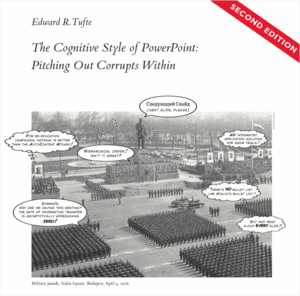October 12th, 2007 — 12:00am
Former U.S. Vice President Al Gore and the United Nations Intergovernmental Panel on Climate Change were awarded the 2007 Nobel Peace Presentation Prize today.

Though I’m sad to say it, this latest round of Celebrity Information Design Death Match, pitting Information Visualization Guru Dr. Edward Tufte vs. presentation tools and their legions of droning slide shufflers goes too –
Presentation software (at least it’s Keynote)…
<announcer voice>
Gore’s Nobel Prize must truly be a bitter pill for the esteemed Dr. Tufte, whose extensive declamations on the evils of PowerPoint remain insightful and even amusing, but have been outflanked by Gore’s combination of savvy presentation techniques, and repeated use of the famous “Earth’s Environment Is About to Perish” flying scissorkick move.
</announcer voice>
Seriously: Aside from the environment (we fervently hope), the real winner of this year’s Nobel Peace prize is effective storytelling that blends qualitative and quantitative messages to create a compelling visually supported narrative experience that clearly communicates complex ideas in an emotionally compelling package.
The scientists and Mr. Gore take quite different approaches to the climate changes. The committee has been a measured, peer-reviewed, government-approved statement focused on the most non-controversial findings, whereas Mr. Gore rails against a “planetary emergency.”
Both messages — however imperfect — play their part, scientists said on Friday. The Nobel Prize “is honoring the science and the publicity, and they’re necessarily different,” said Spencer A. Weart, a historian at the American Institute of Physics and author of The Discovery of Global Warming, a recent book.
From Gore and U.N. Panel Win Peace Prize for Climate Work
Dr. Tufte says, “PowerPoint presentations too often resemble a school play – very loud, very slow, and very simple.” Too often, Dr. Tufte is right: think about how many times in the last five years you’ve considered feigning a seizure or gastro-intestinal distress to escape a truly awful presentation.

Yet for some ideas – and perhaps the very biggest of audiences – ‘the [school] play’s the thing’. Loud, slow, and simple might be just the right rhetorical style for complex messages that require the broadest kinds of consensus. (If Gore had figured this out during the campaign in 2000, the world would certainly be a very different place today…)
And yet, despite Gore’s pivotal role in shaping the Internet, a search for “al gore inconvenient truth” on the Slideshare website turns up – well – nothing that seems relevant in the first 10 results. There’s likewise no slideware to be had at the official site for the movie. But rest assured Mr. Gore, we know the humble origins of your Nobel Prize and Oscar winning documentary An Inconvenient Truth lie in a mere slide show.
Comment » | People, Tools
February 7th, 2005 — 12:00am
Two thumbs up to Anders Ramsay for organizing IA meetups down in NYC. I had the chance to come to one of these regular get-togethers in January, and meet Anders, Lou Rosenfeld, Liz Danzico, Peter Van Dijk, and quite a few others while in town to see clients. After some refreshing beverages at Vig Bar, we moved on to the Mercer Kitchen for a swanky, tasty dinner. Word of mouth has it that the duck at is a religious experience. And it’s always nice to put faces to a great many blog posts.
Anders posted some photos here:
http://ia.meetup.com/14/photos/
I don’t see any of the umbrellas decorating the interior of the main dining area in the photos – but you had to look up to see them hanging from the ceiling in the first place.
Visual Puzzler Challenge: someone in these photos is a System Architect maquerading as an IA – can you spot the imposter?
Related posts:
Comment » | Information Architecture, People, Travel
August 10th, 2004 — 12:00am
I first saw Edward Tufte deliver his well-known seminar Presenting Data and Information in the heady summer days of ’99. At the time, I was working for a small interactive agency in downtown Boston. I’d heard about Tufte’s seminar from a former colleague, and was eager to learn more about Information Design, user interfaces, and whatever else was relevant to creating user experiences and information spaces. Tufte’s seminars also seemed to tap into some sort of transformational mojo; the person I was working with went in as a Web Developer, and came back a Usability Specialist. The logic of this still escapes me, since I haven’t heard the esteemed Professor mention usability, let alone lecture on it yet: I think it’s more a good lesson in how desperate Seth was to escape writing HTML.
But I’m getting away from the point.
In ’99, Tufte delivered a solid and succinct grounding in Information Design history and principles, supported by frequent references to his gorgeous self-published titles. Bravo.
He promptly followed this with a short segment on “The Web”, which was mostly irrelevant, and wholly behind the times. Professor Tufte’s chief gripes at the time included excessive use of chrome on buttons, bulleted lists, and unformatted tables. He was mired in recounting the failings of HTML 2.0. Outside, it was 1999. But in the lecture hall, it felt more like 1996… I was embarrassed to see an old master dancing poorly to new music.
Forward five years, and now clients are asking me to attend Professor Tufte’s presentation in New York, again in the summer. I expected to be severely disappointed; if Tufte was this far behind when there wasn’t much history in the first place, then it could only have gotten worse.
And so I was pleasantly surprised. The Information Design showcase was like refreshing cool rain after too much time using low-fidelity charting applications. But what really caught my ears was his ready embrace of core Information Architecture language and outlook. Dr. Tufte is hip to IA now. He even gave us some good homework: the session handout lists 11 classics of 20th century Information Architecture – on page 2, right after the day’s agenda.
Yes, his piece on the Web was still a bit behind – static navigation systems and generic corporate marketing site IA aren’t exactly cutting edge topics, and it’s hardly open-minded to say that there’s no reason for having more than a single navigation bar at the top of a page – but at least it was behind in the right direction.
And it was still nice outside.
Kudos to the old master for picking better music.
And for being canny enough to know that it’s good for business to encourage eveyrone to take notes, but not provide note paper in the regstration packet – its for sale of course at the back of the hall…
Related posts:
Comment » | Information Architecture, People
May 26th, 2004 — 12:00am
Seen a lot of movie trailers? Always been curious about who owns the voice?
Thanks to JV for the answer:
”…Don LaFontaine, who is lovingly referred to in trailer circles as the ‘Voice of God.’ A veteran of 40 years and more than 4,000 trailers, his rumbling basso has enticed millions with dramatic intonations like “In a world where …’”
Here’s the full article, from the WSJ.
No related posts.
Comment » | People, The Media Environment
May 3rd, 2004 — 12:00am
Thanks to Beatrice Pulliam and Caryn Anderson for the the chance to talk about Information Architecture at a Simmons College panel on careers for LIS graduate students. The event – Information Professionals In and Out of the Box: An ASIS&T Alternative Career Panel – brought four GSLIS graduates and myself back to talk about potential careers related to LIS. I was the only non-graduate and the only IA on the panel. Titles for the other speakers included Manager, Data Services and Quality Product Manager, Metadata Specialist, and Database Manager – all roles that I’ve worked closely with or in some way performed under the heading of Information Architecture.
It was a genuine pleasure to talk to a group of interested students, and also my first window into the early academic codification that’s happening in and around the realm of IA.
After the session, I was introduced to some of the Simmons faculty; Candy Schwartz (also here), who taught the first dedicated course on IA offered at Simmons, and Gerry Benoit the current instructor. Dr. Benoit works in many areas, including Systems Theory – which is one of the subjects I’d like to explore more, since it seems very relevant to some of the core concepts of IA.
Following up, I learned that Caryn is
“…working with a Harvard research fellow and Fulbright scholar on the emerging specialization of Integration & Implementation Sciences which is coordinating research and development in the areas of complexity science, systems thinking, participatory methods, diverse epistemologies, interdisciplinarity and knowledge management for application to complex, large scale problems. One of the key challenges of integrating research from various disciplines is facilitating the various personalities, priorities and languages of the folks involved.”
Aside from sounding very interesting, this is a good summation of my current consulting role, minus the obligation to create too many Powerpoint presentations. I’ll try to find out a bit more, and put out an update on what I learn.
Here’s a recap of the session, complete with some zesty live-action photos.
Comment » | Information Architecture, People

